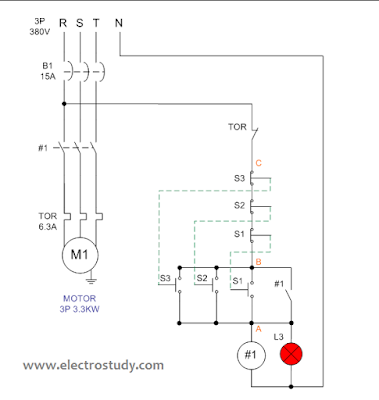Wiring diagram 3 phase motor 3.3 kW with three unit of BSH 222 switch
We will use three unit of BSH 222 switch for control a motor glue pump. The glue must distribute to three different location, such us Line1, Line2 and Line3. Each switch store in each Line location.
BHS 222 switch has an two contacts switch, NO (Normally Open for ON button) Contact and NC (Normally Close for OFF button) contact. In wiring 3 Phase motor 3.3 kW with three unit of BSH 222 switch, we use to series connection the NC contact and to parallel connection the NO contact.
Wiring diagram 3 phase motor 3.3 kW with three unit of BSH 222 switch
Electric parts needed for the wiring 3 Phase motor 3.3 kW with three unit of BSH 222 switch above:
- B1 = MCB 15A 3 phase
- M1 = Motor 3.3kW 380V 3Phase
- #1 = Magnetic contactor 220VAC
- TOR = Thermal overload relay 6.3A
- S1, S2, S3 = Push button switch type BSH 222
- L3 = Pilot lamp 220VAC
Wiring connection of BSH 222 switch
BHS 222 switch has an two contacts switch, NO (Normally Open for ON button) Contact and NC (Normally Close for OFF button) contact. In wiring 3 Phase motor 3.3 kW with three unit of BSH 222 switch, we use to series connection the NC contact and to parallel connection the NO contact.












